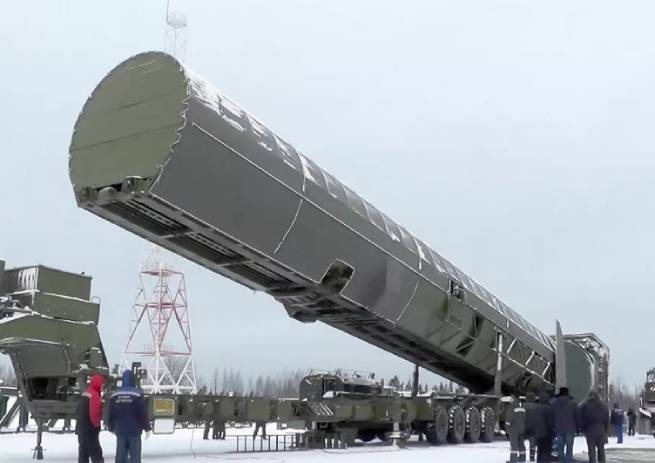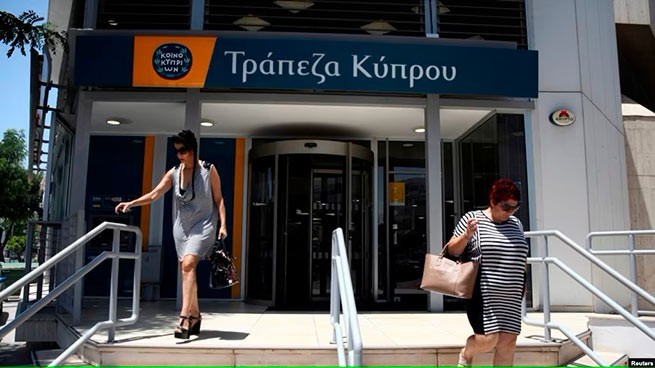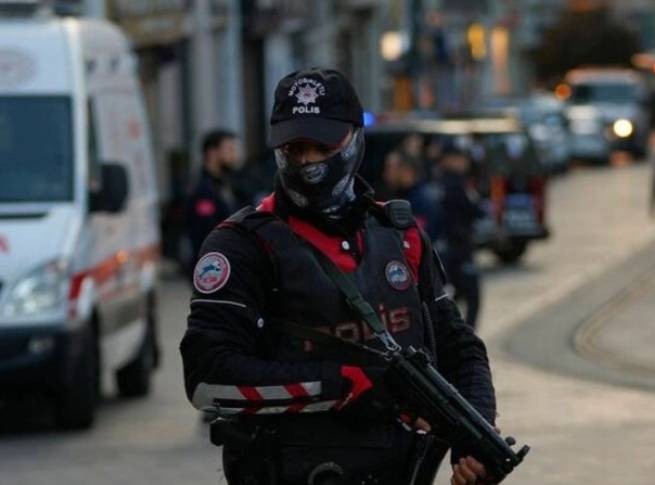Satellite images taken last month show a failed test launch of the RS-28 Sarmat missile, Russia's “world's deadliest” nuclear weapon.
They forced weapons experts writes Euronews, assume that Russia attempted to test its newest intercontinental ballistic missile but was a disastrous fiasco.
What is “Sarmat”? The 35-metre-long missile, capable of carrying nuclear warheads, has been dubbed “Satan 2” and “the world's deadliest weapon” in Russian and foreign media, adding to concerns about its supposed destructive capabilities.
The latest images show a large crater at the launch site in Plesetsk in northern Russia. Information about this was first published on September 21 on the social network X by an analyst under the pseudonym “MeNMyRC”:
“As is obvious, the test of the RS-28 Sarmat was a complete failure. The missile exploded in the silo, leaving a huge crater and destroying the test site.”
My thanks to @MT_Anderson for providing this Planet Labs imagery and allowing me to publish it with comments.
As is readily apparent, the RS-28 Sarmat test was a complete failure. The missile detonated in the silo leaving a massive crater and destroying the test site. The… https://t.co/FuKIaTNFVs pic.twitter.com/AuIpQRrDLa
— MeNMyRC (@MeNMyRC1) September 21, 2024
MeNMyRC suggests that the rocket may have exploded while being filled with liquid fuel rather than at launch. This may explain the absence of aircraft that were supposed to observe the test launches. If the experts are right, this will be the fourth known failure of the RS-28. The only confirmed successful test attempt of this weapon was made in April 2022.
The BBC publication wrote on September 23 that a serious accident probably occurred at the Russian military cosmodrome Plesetsk on September 20. OSINT researchers and experts believe it was most likely a failed test of an RS-28 Sarmat intercontinental ballistic missile, which appears to have exploded in a launch silo. Based on available information, the BBC tried to recreate a picture of what happened. Images from September 21 and 23 show that part of the launch complex was very badly damaged.
In addition, the NASA FIRMS service, which promptly informs about major fires around the world, reportedthat on September 20 it was noticed at this site severe fire. So strong that it was visible from space.
ABOUT political significance for Putin, RS-28 is told by Matt Korda, senior researcher at the Stockholm International Peace Research Institute (SIPRI). Sarmat is intended to functionally replace the RS-20V Voevoda missile, created more than 30 years ago:
“Russia has long been planning to replace all of its Cold War-era delivery systems with newer versions, and the RS-20V Voevoda is the last intercontinental ballistic missile of this type remaining in its arsenal. As a result, the introduction of Sarmat will have political significance for the president Putin, as the personification of Russia’s completion of this long-awaited transition.”
The RS-28 complex was first presented in 2014 at a press conference in Moscow. Russian officials then said the missile would be ready by 2020. Production was then delayed several times due to manufacturing, production and testing issues.
April 20, 2022 is said to have taken place the first and only successful test of the Sarmat missile. This is truly a unique case in the history of the development and production of intercontinental ballistic missiles. This was admitted by the head of the developer – the State Rocket Center named after V.P. Makeev [ГРЦ Макеева]which is part of the Roscosmos State Corporation, Vladimir Degtyar:
“On April 20, 2022, the Sarmat intercontinental ballistic missile was successfully launched from the 1st State Test Cosmodrome Plesetsk – the first in the state flight test program. The launch tasks were completed in full. The training combat units arrived at the designated area on the Kura battlefield. […] The Sarmat missile system has already been put into serial production.”
According to Korda, to date the RS-28 has still not entered service. The expert explains:
“Not only was serial production of the missile delayed, but its test cycle was marred by a number of delayed and unsuccessful tests.”
Since the launch of the missile, Russian media have reported that The RS-28 can carry up to 16 independently targetable nuclear warheads. However, Korda believes that this number is most likely much lower – “possibly up to 10 warheads.” According to the Russian military, the missile has a range of at least 18,000 km and weighs more than 208 tons.
In October 2023, Russian President Vladimir Putin said that RS-28 is ready for deployment:
“We have actually finished work on the Sarmat, on the super-heavy missile. The question is that we just need to complete some procedures in a purely administrative and bureaucratic manner, move on to their mass production and putting them on combat duty. And we will do this in the near future.” .
In the same speech, the President of the Russian Federation emphasized one of the goals of the RS-28 – to discourage nuclear and military escalation by the United States. He emphasized that Russia signed and ratified the Comprehensive Nuclear Test Ban Treaty, while the United States only signed it.
The proposed agreement would ban all nuclear explosions for both military and peaceful purposes. In order for it to come into force, it must be ratified by 44 nuclear-capable states before the UN Secretary General.
In November 2023 Putin revoked Russian ratification in order to repeat the US position. Since several countries with nuclear capabilities still refuse to sign or ratify the treaty, Weapon testing continues around the world.
According to Korda, the production of missiles like the RS-28 Sarmat is only part of the modernization process through which “all states possessing nuclear weapons” are going through.
It remains unclear what the real status of these weapons is after the fourth supposed failed test. Putin and Russian media claim the RS-28 has been operational for years, but September images of the crater cast doubt on those claims by many experts. Sometimes information leaks into the air, like this video.
Korda is confident that, despite any problems with testing, Russia will continue to work on the RS-28:
“Russia is apparently continuing construction to facilitate missile deployment. Satellite imagery shows major construction is well underway at the 62nd Missile Division's first regiment in southern Siberia and will begin soon at other proposed deployment sites.”
Expert Maxim Starchak said in an interview with the Russian BBC Service:
“The Sarmat missile is a crude project. Roscosmos expected to conduct six successful tests, but reported only one. Taking into account the experience of Roscosmos, I can assume that from 2022 there could be another 4-5 startup attempts. They were probably really unsuccessful.”
Starchak answers to a question from journalists about what could have caused the accident of “Satan”:
“The mere fact that the Sarmat rocket uses toxic, explosive and fire-hazardous liquid fuel based on heptyl already poses a potential danger. My experience of observing the creation of this rocket says that the rocket as a whole has a lot of technical problems. This is not the first unsuccessful launch And a lot could happen:
- An explosion could have occurred while loading fuel if certain procedures were not followed.
- An explosion could also occur during fuel unloading, [в момент]when a technical problem was discovered and the launch was interrupted.
- A fuel leak could have occurred during preparation for the rocket launch if some design errors appeared. Contact of fuel with flammable vapors would result in an explosion.
- The first stage engine could also explode immediately after ignition or startup.
- The command to start the engine might not have passed, and the rocket fell back, exploding and destroying the silo.
But most importantly — These are not even technical problems with the rocket. Somehow they will bring her to mind. And the fact that the rocket silo collapsed. It will take months or even years to restore it or build a new one. This means that Russia will significantly delay the Sarmat test program and will find itself without a technically ready heavy missile for a long time. “Voevoda”* I haven't flown for over 10 years. “Sarmat” has also not been flying for two years.”
One of the reasons for such a rapid pace of development of a new rocket, which often appears in comments on this project, is called refusal of Ukrainian developers from the Yuzhmash company to service the R-36M Voevoda missileswhich were in service with Russia's strategic nuclear forces.
*”Voevoda” is a Soviet R-36M strategic missile system with a heavy intercontinental ballistic missile. After the collapse of the USSR, the development of the project was carried out by the Russian Federation jointly with the Ukrainian design bureau “Yuzhnoye”. The complex is designed to engage all types of targets protected by modern missile defense systems in any combat conditions, including multiple nuclear impacts in a positional area. Its use makes it possible to implement a strategy of a guaranteed retaliatory strike.






More Stories
In the US, there is outrage over the decision of J. Biden and C. Harris to donate… $750 to hurricane victims "Helen"
S. Balaskas about the gypsies: “We will bring them blood, we will enter their houses”
Greeks lost more than 40 billion euros to banks